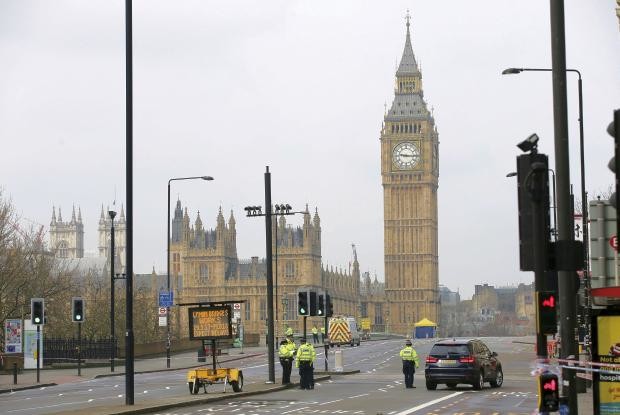
Police work at Westminster Bridge with the Houses of Parliament in background, in London, Thursday March 23, 2017. On Wednesday a knife-wielding man went on a deadly rampage, first driving a car into pedestrians on Westminster Bridge then stabbing a police officer to death before being fatally shot by police within Parliament’s grounds in London. (Photo by TIM IRELAND / AP)
LONDON — It is one of the most famous buildings in the world, a proud symbol of Britain’s heritage, yet events have shown it to be surprisingly vulnerable.
Britain’s Parliament, home to its centuries-old experiment with democracy, now sports an ungainly blue evidence tent on its grounds.
The perimeter of the buildings used by silver-tongued orators like Winston Churchill has been violated. Forensics experts Thursday searched on their hands and knees for microscopic clues to the rampage that so far has claimed four lives, including the attacker.
A British-born man first struck down pedestrians on Westminster Bridge with an SUV and then fatally stabbed a police officer guarding Parliament’s courtyard in Wednesday’s attack. The man was then shot dead by police. The Islamic State group has claimed responsibility for the attack.
Magnus Ranstorp, an expert on extremist tactics with the Swedish Defense University, said Parliament’s buildings are well-protected but that little can be done to stop an individual from using a vehicle to attack pedestrians and then enter the grounds on a suicide mission.
“It’s quite a hardened target, you would have to have significant firepower to come in through multilayered security,” Ranstorp said. “He was never anywhere near the buildings. But he did what one person could do by mowing down people. You couldn’t prevent that.”
One of the most memorable scenes from 2012 James Bond film “Skyfall” was a fictional attack on Parliament, and Wednesday’s violence showed how difficult it is to protect a public ceremonial building in an open society.
The entries to the buildings themselves are protected by airport-style security and ID checks, but keeping the parliamentary grounds safe is far more difficult. Part of the problem lies in the way the modern British capital grew up around the site, which was first used for a Saxon church early in the eighth century.
A major road runs directly in front of Parliament, right past the Big Ben tower, bringing fast-moving traffic and heavy trucks across the Westminster Bridge into direct proximity with the buildings.
The grounds are protected by a security perimeter, with a mixture of armed and unarmed police, but the vehicles pass much closer to the buildings than is the case, for example, with the White House or US Capitol in Washington.
That raises the threat of a car bomb attack, or a motorist who, like the attacker Wednesday, uses a vehicle to run over pedestrians – at one of the most popular tourist sites in the city – and then rams the gates and penetrates the complex on foot.
In this case, the attacker is believed to have entered the grounds via open, unguarded 10-foot high wrought iron gates.
Dozens of vehicles also enter the complex each day, delivering food for its restaurants and cafes, supplies for its offices, and bringing VIPs onto the grounds. The cars are checked but are relatively close to the buildings at that point.
There was heightened security Thursday, and school tours were cancelled, as Parliament went back to work. –Gregory Katz